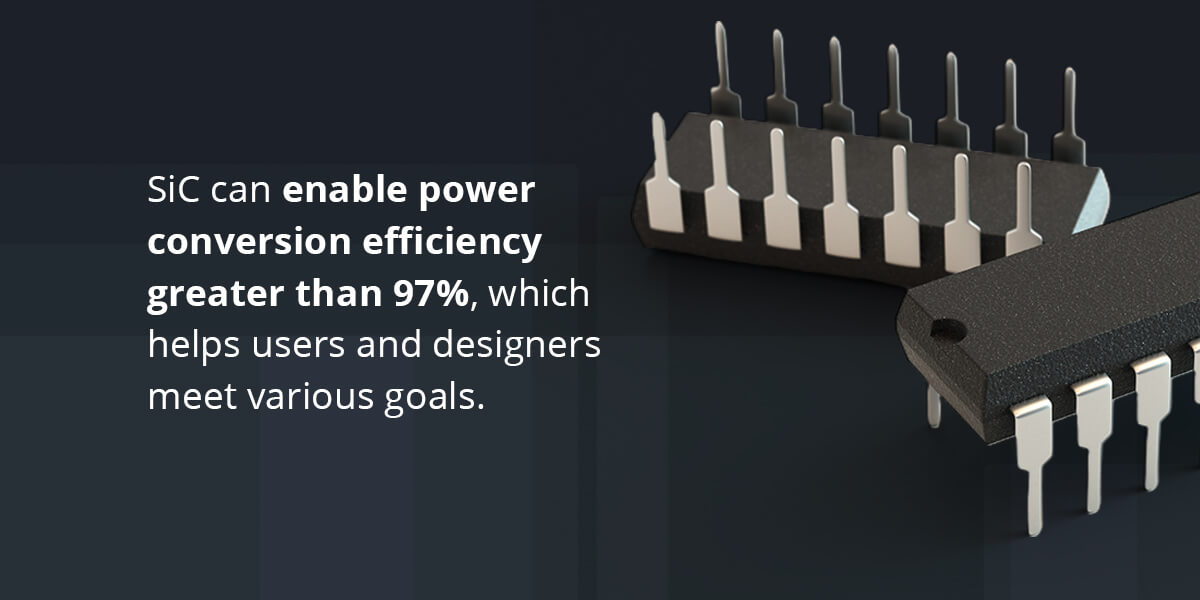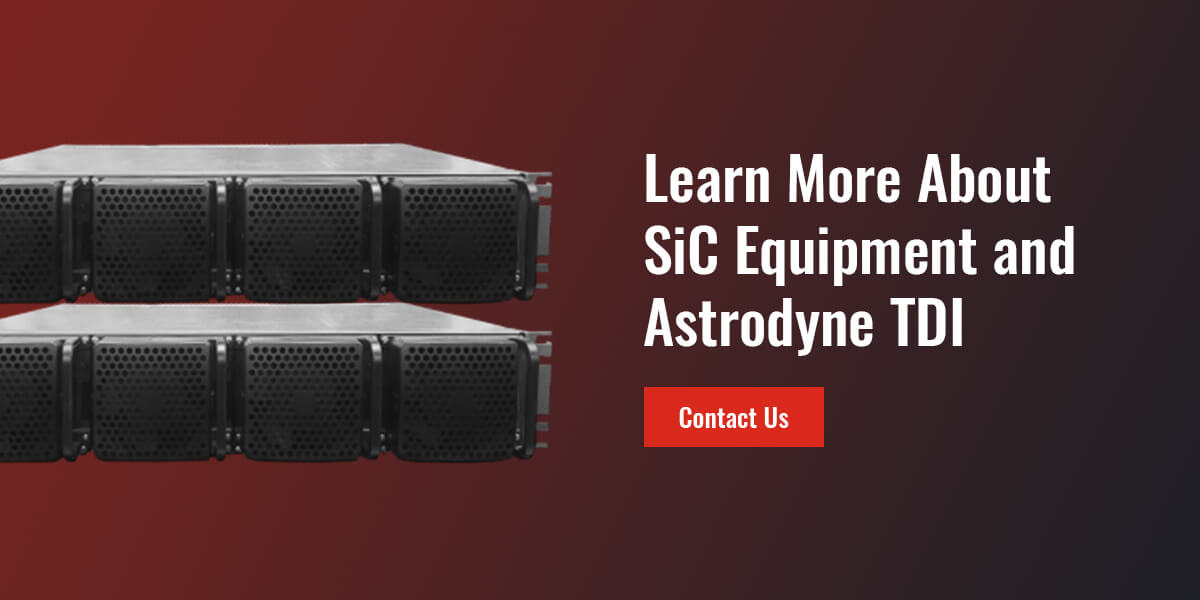RESOURCES
How Is SiC Used in Power Supplies?
Silicon is the traditional material of choice for semiconductors, but its close relative, silicon carbide (SiC), has appeared recently as a fierce competitor. The characteristics of SiC lend themselves especially well to high-heat, high-voltage applications. It offers higher efficiency and expands capabilities in areas like power density and operating temperatures.
This unique material is helping to make power supplies smaller and more efficient. Let's explore how that's happening and what SiC has to offer in the world of power supplies.
What Is SiC in Power Applications?
There are six major benefits to SiC over Si, such as:
- High energy efficiency
- Low power and switching losses
- High thermal conductivity
- High operating frequency and temperature
- Excellent thermal management and thermal shock resistance
- Long life span
These benefits make SiC an ideal material for power applications across industries. Two common power supply components that use SiC are diodes and metal oxide semiconductor field-effect transistors (MOSFETs).
The Role of SiC in Power Supplies
One of the main reasons SiC is so useful in power supplies is that it functions as a wide bandgap material. A material with a wide bandgap requires more energy before it moves an electron from the valence band to the conduction band. When this happens, the material becomes a conductor. Silicon only has a bandgap of 1.12 electron volts (eV), while SiC has a bandgap of 3.2 eV. The wider bandgap means that SiC can sustain the same voltage as a silicon semiconductor in a much thinner design.
The thinner material of SiC offers several advantages for power supplies. It reduces losses from conduction and switching, which can increase switching speeds and reduce heat for smaller, more efficient and longer-lasting power supplies.
Virtually every industry benefits from these compact, efficient power supplies since there is a growing need for technology like automated equipment and data gathering. Industrial applications, data centers and other high-heat, high-voltage users are particularly interested in SiC, which can significantly reduce the costs of running and cooling facilities — which often operate 24/7 — while making the most of valuable space.
SiC can also improve performance over time, as it stands up well to thermal stress. Greater efficiency helps to minimize heat, giving SiC a longer life span and making it more reliable. These characteristics can be especially useful in demanding or mission-critical applications like ruggedized power supplies or military devices.

5 Benefits of SiC in Power Supplies
The benefits of using silicon carbide power devices are extensive and affect everything from operating temperatures to design flexibility. SiC advantages include:
- Improved efficiency: SiC can enable power conversion efficiency greater than 97%, which helps users and designers meet various goals. One of the best ways to reduce costs is to avoid using power in the first place, and SiC can help immensely. It allows users to satisfy internal demands for reduced costs, along with external quality standards and government regulations, all within an affordable system. Many SiC power supplies can meet the 80 Plus Titanium Standard with reduced costs.
- Cost savings: Reduced energy consumption is one of the primary ways SiC power supplies save users money, but they can also provide savings through smaller footprints and improved reliability that limits downtime and maximizes value. Strong thermal conductivity and efficiency reduce the need for cooling components, too.
- Increased power density: Thanks to its high efficiency and low heat, SiC can greatly improve power density, particularly in high-voltage applications. These tightly packed designs are ideal for building smaller, lighter power supplies without sacrificing performance and power.
- Improved reliability: SiC can handle high operating temperatures and voltages. It withstands environments up to 200 degrees Celsius and is often used with in-field effect transistors in applications as high as 10 kilovolts. Its efficient performance gives it a long life span, too. Many demanding applications benefit from the dependability of SiC-based power supplies.
- Improved versatility: With its high power density and efficient operation in high-heat, high-voltage environments, SiC is used across industries and devices to deliver powerful, cost-effective solutions that balance flexibility and power density demands. SiC offers exceptional value in industrial installations, but many industries, like aerospace and health care, also benefit from the flexibility and rugged capabilities of silicon carbide applications.
SiC vs. Si in Power Applications
Silicon has been around for decades, and many designers rely on it as a tried-and-true material. While it works well in low-powered applications, its limitations become clear when working with high-powered devices. Where silicon starts to break down, SiC keeps going. It can operate at higher temperatures, frequencies and voltages thanks to its wide bandgap.
While silicon operates up to 150 degrees Celsius, SiC can go an extra 50 degrees Celsius higher. It can support switching frequencies and voltages up to 10 times higher than silicon.
In many cases, silicon reduces the turn-on resistance that can occur at high breakdown voltages. However, this can increase switching losses and problems with heat generation. These issues prevent silicon from being effective in high-frequency applications. SiC can offer these low turn-on resistances at high voltages and high speeds.
Some areas where SiC shines include:
- Electric vehicle charging: Charging stations for electric vehicles have unique electrical demands, including high efficiency, ruggedness, bi-directional energy flow and high power density. SiC's fast switching can reduce the number of components needed and deliver more power in a smaller space, which is ideal for charging multiple vehicles from one station.
- Power factor correction: Increasing the power factor of a power supply can smooth out short, high-magnitude pulses to use the incoming power more effectively. SiC's high-frequency capabilities help to reduce the size and number of components for power factor correction to improve cost, power density and thermal management.
- Data center power supplies: Servers use a massive amount of power and run constantly. The high efficiency of SiC can translate to exceptional cost savings and reduced energy use, which become more and more relevant as data demands climb.
- Industrial applications: Industrial equipment often relies on high voltages and speeds that SiC can offer to achieve exceptional precision and power for dependable operations.
- Renewable energy: As the renewable energy field grows, SiC offers an attractive way to help meet high-voltage, high-power demands without turning to fossil fuels or nuclear power. By accommodating these applications with low costs and reduced complexity, SiC helps make renewable energy a more viable solution and allows many users to limit their power consumption.

Learn More About SiC Equipment and Astrodyne TDI
SiC-based power supplies offer significant advantages over their silicon counterparts. If you work with high-powered applications, using SiC can help you meet your goals, such as reducing costs, improving efficiency and boosting reliability. At Astrodyne TDI, we specialize in power supplies optimized for your application.
We serve some of the strictest, most demanding industries like the military, industrial and medical fields. Our knowledgeable team can help you make the most of SiC with off-the-shelf and custom solutions, all backed by top-tier certifications. To learn more about SiC equipment and how we can help you on your next project, please reach out to an expert today!

